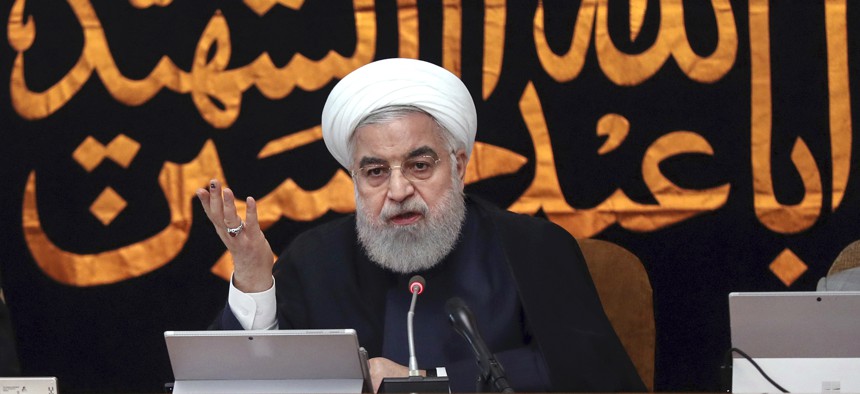
In this photo released by the office of the Iranian Presidency, President Hassan Rouhani speaks in a cabinet meeting in Tehran, Iran, Wednesday, Sept. 4, 2019. Iranian Presidency Office via AP
Everyone Is Getting Sucked Into the Iran Morass
The U.S. threatened Iran after an attack on a Saudi oil field sent global energy prices soaring, showing how the tensions affect literally everyone.
After a summer of escalations between the United States and Iran, the past few weeks seemed almost civil. President Donald Trump was openly suggesting that he could meet with Iranian President Hassan Rouhani. But just as quickly, the pendulum swung back, with an attack on a critical Saudi oil facility over the weekend that temporarily knocked out about half the country’s oil capacity or 5 percent of global supply, according to CNN.
Almost immediately, Trump, who habitually boasts of American might but just as strongly bemoans U.S. entanglements overseas, was back to threatening tweets. He declared the U.S. “locked and loaded,” again raising the specter of a U.S. conflict with Iran. But how likely is that really?
The attack on the oil facility, operated by Saudi Arabia’s national oil company Aramco, had major and sudden consequences. Even as Saudi Arabia, the actual victim, declined to directly name Iran as the culprit, the Trump administration was quick to do so—and Energy Secretary Rick Perry called it no less than an attack on the global economy.
Oil prices jumped in short order, and so an explosion in the eastern Saudi desert reverberated across the globe. The message, from whoever sent it: An escalation in the Middle East isn’t going to stay in the Middle East. Everyone’s going to feel it.
Related: Key Republicans More Eager to Help Saudi Arabia Than Fight Iran
Related: Alleged Israeli Strikes Bring US to Crossroads in Iraq
Related: 70 Percent of Americans Say Arms Sales Make US Less Safe
As for the messenger, there was little to go on as of yesterday, other than assertions from parties with vested interests, none of whom have complete credibility: Trump officials (Iran); Trump (it looks like Iran, but still investigating); Saudi Arabia (not sure, but the weapons were Iranian); Iran (not Iran); and Yemen’s Houthi rebels, who are aligned with Iran and are being bombed in a Saudi-backed air campaign (themselves).
Regardless, the attack demonstrates in dramatic fashion just how vulnerable the region’s energy infrastructure is, which has unmistakable implications for America’s Iran policy. For the first year of Washington’s so-called maximum-pressure campaign against the Islamic Republic, the Iranians bore escalating sanctions with barely a peep of direct retaliation, creating the temporary illusion that the U.S. could use its own financial power to virtually cripple another country’s economy at no cost to itself.
The illusion persisted even when the U.S. moved to cut off all of Iran’s oil exports, which in May numbered more than a million barrels a day. The move did not appreciably raise oil prices despite the supply disruption, but the policy’s cost became clear in other ways. Iran appeared to change its strategy and stepped up its confrontations. If Iran couldn’t export its own oil, it was going to try making it very difficult for others to do so.
At least in geographic terms, the circle of retaliation was small, confined mainly to Iran’s immediate neighborhood—most notably through Houthi strikes from Yemen into Saudi Arabia, and tanker explosions (for which Iran denied responsibility despite U.S. accusations) and drone shootdowns near the Strait of Hormuz over the summer. But the circle was never as small as it looked. Saudi Arabia, the United Arab Emirates, Norway, and Japan were all embroiled in tankers hit over the summer; Singapore and Taiwan had some imports disrupted; China, India, and South Korea are among the other major destinations for oil passing through the Strait of Hormuz. Other than Iran’s regional Saudi and Emirati rivals, none of those other countries sucked into the summer’s escalation had much to do with the U.S.-Iran confrontation otherwise.
Over the weekend, the circle expanded further still. Global oil prices had surgedabout 15 percent yesterday afternoon, the largest one-day increase in about a decade, according to The Wall Street Journal. Even as Perry was condemning the attacks and Trump was warning darkly of consequences, both also simultaneously tried to sound reassuring for the rest of the world. Oil markets remain well-supplied—OPEC declined yesterday to increase production, and unnamed Saudi officials told The Wall Street Journal that they feared a production increase would cut into their market share. The 15 percent jump is a big one in relative terms, but oil prices remain well below where they were five years ago, when Barack Obama was pursuing his own sanctions campaign against Iran in pursuit of the nuclear deal. In the summer of 2014, for example, oil prices went above $100 a barrel; yesterday they hit about $66 a barrel.
If there’s a way out, meanwhile, it’s foggy, and the path is obscured further by the ever-contradictory statements coming from different centers of power in the administration—or sometimes from the very same person. Having repeatedly and specifically said he would meet with the Iranians with no preconditions, Trump tweeted Sunday night that reports about his own prior position were false. (“The Fake News is saying that I am willing to meet with Iran, ‘No Conditions.’ That is an incorrect statement (as usual!).”) On Sunday he declared the U.S. “locked and loaded depending on verification” of who conducted the attack (his secretary of state had already fingered Iran as the culprit); by yesterday he was telling reporters that “we’d certainly like to avoid” conflict with Iran, that diplomacy was “never exhausted,” and “I know they want to make a deal.” (Perhaps not soon, though: Iran’s Supreme Leader Ayatollah Ali Khamenei later ruled out talks with the U.S. “at any level.”)
Trump’s remarks yesterday were consistent with his oft-stated desire to avoid a conflict. (“I don't want war with anybody,” he said. “I’m somebody that would like not to have war.”) Even as the military has built up forces in the Gulf, Secretary of Defense Mark Esper has said in the past that the point is to avoid a conflict, not to start one. The conditions John Bolton laid out in May for the use of “unrelenting force” against Iran, namely an attack on U.S. interests or those of its allies by Iran or its proxies, have long since been satisfied; but Bolton is gone now and no one knows where the real line is. All of which suggests that Iran and its allies may well keep walking up to it. And if for some reason they stumble over, it seems neither the Iranians nor the American people will know ahead of time what could start a war.
NEXT STORY: Selling F-16s to Taiwan Is Bad Business




